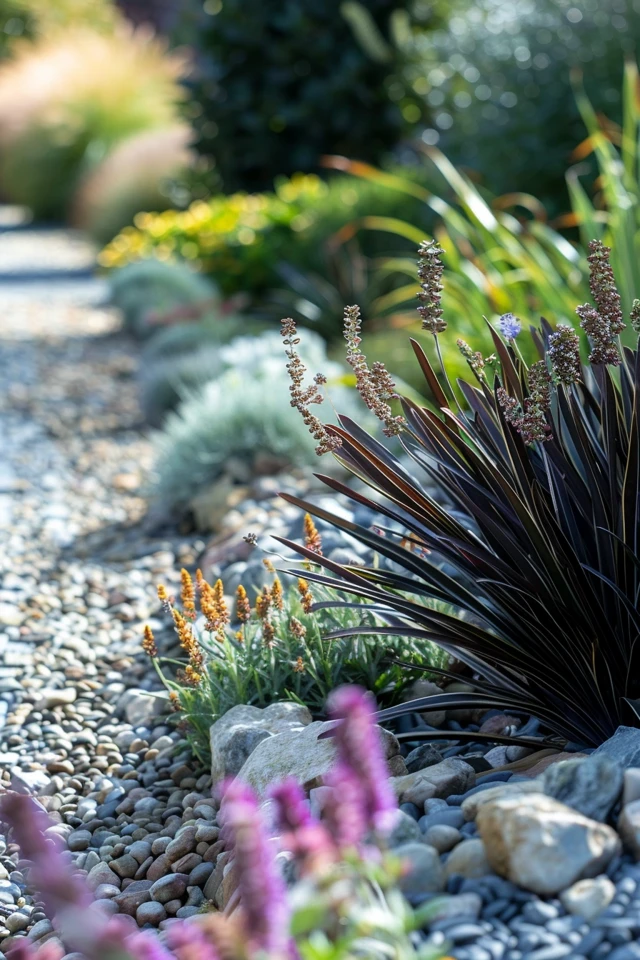As a homeowner in Utah, I understand the importance of sustainable gardening practices, especially when it comes to water conservation. That’s why I’m excited to share some Utah xeriscape ideas with you.
Xeriscaping is a landscaping strategy that focuses on creating gardens that are drought-tolerant, low-maintenance, and eco-friendly. By implementing these ideas, you can not only save thousands of gallons of water each year but also create a beautiful and sustainable landscape.
Key Takeaways:
- Utah xeriscape ideas offer a water-wise solution for homeowners.
- By incorporating native plants and hardscaping elements, you can create a stunning and sustainable landscape.
- Xeriscaping in Utah helps conserve water, reduces maintenance, and saves money.
- Check with local authorities for any permits required for landscape designs.
- Implementing rain barrels, mulch, and rock gardens can further enhance the sustainability and aesthetics of your xeriscape design.
By embracing these Utah xeriscape ideas, you can make a positive impact on the environment while enjoying a beautiful and vibrant garden all year round.

Choosing the Right Plants and Incorporating Hardscaping
When it comes to designing a stunning and sustainable xeriscape in Utah, selecting the right plants plays a crucial role. By choosing native plants that are well-adapted to the local climate and require less water, you can create a low-maintenance and eco-friendly landscape. Let me share some tips on selecting the perfect plants and incorporating hardscaping elements to enhance your xeriscape design.
Low Water Landscaping Tips
One of the key principles of xeriscape design is to conserve water while still achieving a beautiful landscape. Here are some low water landscaping tips:
- Opt for native plants: Native plants have evolved to thrive in the specific climate and soil conditions of Utah. They are well-suited for xeriscaping and require less water compared to non-native species.
- Choose drought-tolerant plants: Look for plants that are naturally adapted to dry conditions. These plants have mechanisms to conserve water and can withstand periods of drought without compromising their beauty.
- Consider plant spacing: Proper spacing between plants allows for better air circulation, reduces competition for resources, and promotes healthier growth.
- Apply mulch: Mulching around plants helps retain moisture in the soil, suppresses weed growth, and adds an aesthetic touch to your xeriscape.
Native Plants for Utah Xeriscaping
Utah is home to a diverse range of beautiful and hardy native plants that are perfect for xeriscaping. Here are a few popular choices:
- Little Bluestem Grass: This ornamental grass adds texture and movement to your landscape with its vibrant foliage that transitions from blue-green to bronze.
- Karl Foerester Grass: With its upright growth habit and feathery plumes, this grass provides a stunning focal point in any xeriscape design.
- Lavender: Known for its fragrant blooms and silvery foliage, lavender not only adds color but also attracts pollinators to your garden.
Xeriscape Plant Inspiration and Desert Landscaping Ideas
When planning your xeriscape, it’s always helpful to gather inspiration and ideas. Take a stroll through local botanical gardens, visit xeriscaped properties in your area, or explore online resources for desert landscaping inspiration. You’ll find a wealth of creative ideas and plant choices that will suit your taste and the unique features of your landscape.
Xeriscaping allows us to create beautiful, low water landscapes that not only conserve resources but also reflect the natural beauty of our surroundings.” – Richard, Utah homeowner

Xeriscape Design Principles
Designing an effective xeriscape involves considering various principles that ensure a harmonious and sustainable landscape. Here are some xeriscape design principles to keep in mind:
- Water conservation: Implement efficient irrigation systems, adopt water-saving practices, and choose plants that require minimal watering.
- Appropriate plant selection: Select plants that are well-suited to the local climate, soil conditions, and available sunlight.
- Soil improvement: Improve soil quality by incorporating organic matter, such as compost, to enhance moisture retention and nutrient availability.
- Hardscaping elements: Incorporate hardscaping elements like natural stone pathways, gravel beds, and patio areas to add structure and functionality to your xeriscape.
By following these xeriscape design principles, you can create a visually pleasing landscape that maximizes water efficiency and minimizes maintenance requirements.
Now that you have a better understanding of selecting the right plants and incorporating hardscaping elements for your xeriscape, let’s explore the benefits of a drought-resistant landscape in the next section.

Benefits of a Drought-Resistant Landscape in Salt Lake City
Living in Salt Lake City and its surrounding areas in Utah means dealing with drought conditions. That’s why homeowners in this region should seriously consider drought-resistant landscaping. By embracing a xeriscape design, you’re not only contributing to water conservation efforts but also reaping numerous benefits for your property and the environment.
A drought-resistant landscape offers reduced water usage, which translates to cost savings on your water bill. With native plants that are adapted to the local climate, you’ll enjoy a low-maintenance yard that requires less watering and upkeep. Say goodbye to time-consuming, water-intensive gardening tasks and hello to a stress-free outdoor space that thrives even during dry spells.
Not only is a xeriscape design water-wise and low-maintenance, but it’s also incredibly eco-friendly. By conserving water and using sustainable practices, you’ll be reducing your ecological footprint and contributing to a healthier planet. To enhance the sustainability and aesthetics of your drought-resistant landscape, consider incorporating elements like rain barrels to capture and reuse water, mulch to retain moisture, rock gardens for visual interest, and hardscapes that add functional and beautiful spaces to your yard.

